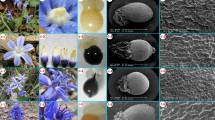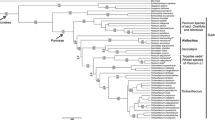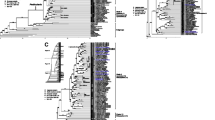Abstract
The genus Scirpus L. s.l. (Cyperaceae) has been accepted as a polyphyletic taxon by most plant taxonomists. This genus was separated into different genera by several different authors: Scirpus s. str., Trichophorum Pers., Bolboschoenus (Asch.) Palla, Schoenoplectus (Rchb.) Palla, and Schoenoplectiella Lye. The heterogeneity of Korean Scirpus s.l. has not yet been studied. We examined 17 taxa of Korean Scirpus s.l. by morphological characters and phylogenetic analyses based on nuclear ITS and chloroplast rbcL sequences. Phylogenetic analyses using maximum parsimony, maximum likelihood, and Bayesian method provided sufficient resolution. The phylogeny revealed the polyphyly of Korean Scirpus s.l. with five distinct clades. These clades correspond to Bolboschoenus, Schoenoplectus s.str., and Schoenoplectiella, Scirpus s.str., and Trichophorum, respectively. These five genera were delimited in terms of the morphology of tuber, bract, and inflorescence. By virtue of our findings, we suggest that the 17 taxa of Korean Scirpus s.l. should be placed into five genera as follows: Bolboschoenus (two species), Schoenoplectus (three species), Schoenoplectiella (six species), Scirpus s.str. (five species), and Trichophorum (one species).


Similar content being viewed by others
References
Amat JA (1995) Effects of wintering graylag geese Anser anser on their Scirpus food plants. Ecography 18:155–163
Ascherson P (1864) Flora der Provinz Brandenburg der Altmark und des Herzogthums Magdeburg, vol 3. Berlin, pp 753–754
Beetle AA (1949) Annotated list of original descriptions in Scirpus. Am Midl Nat 41:453–493
Bruhl JJ (1995) Sedge genera of the world: relationships and a new classification of the Cyperaceae. Aust Syst Bot 8:125–305
Chen DH, Ronald PC (1999) A rapid DNA minipreparation method suitable for AFLP and other PCR applications. Plant Mol Biol Report 17:53–57
Chung T (1957) Korean Flora, vol 2. Shinjisa, Seoul, pp 797–856, in Korean
Dahlgren RMT, Clifford HT, Yeo PF (1985) The families of the monocotyledons. Springer Verlag, Berlin, pp 407–418
Doyle JJ, Doyle JL (1987) A rapid DNA isolation procedure for small quantities of fresh leaf tissue. Phytochem Bull 19:11–15
Goetghebeur P (1986) Genera Cyperacearum. Ph.D. thesis. University of Ghent, Belgium
Goetghebeur P (1998) Cyperaceae. In: Kubitzki K (ed) The families and genera of vascular plants, vol 4. Springer Verlag, Berlin, pp 141–190
Govaerts R, Simson DA, Bruhl J, Egorova T, Goetghebeur P, Wilson K (2007) World checklist of Cyperaceae, Sedges. Royal Botanical Gardens, Kew
Hall TA (1999) BioEdit: a user-friendly biological sequence alignment editor and analysis program for Windows 95/98/NT. Nucleic Acids Symp Ser 41:95–98
Hastings WK (1970) Monte Carlo sampling methods using Markov chains and their applications. Biometrika 57:97–109
Hipp AL (2008) Phylogeny and patterns of convergence in Carex sect. Ovales (Cyperaceae): evidence from ITS and 5.8S sequences. In: Naczi RFC, Ford BA (eds) Sedges: uses, diversity, and systematics of the Cyperaceae. Missouri Botanical Garden, St. Louis, pp 197–214
Hirahara T, Katsuyama T, Hoshino T (2007) Suprageneric phylogeny of Japanese Cyperaceae based on DNA sequences from chloroplast ndhF and 5.8S nuclear ribosomal DNA. Acta Phytotaxon Geobot 58:57–68
Hitchcock CL, Cronquist A (1973) Flora of the Pacific Northwest. University of Washington Press, Seattle and London, pp 600–602
Jung J, Choi H-K (2010) A new endemic species in Trichophorum (Cyperaceae) from South Korea. Novon 20 (in press)
Kim C, Na HR, Choi H-K (2008) Conservation genetics of endangered Brasenia schreberi based on RAPD and AFLP markers. J Plant Biol 51:260–268
Komarov VL (1901) Flora Manshuriae, vol 1. Petropoli, pp 339–345
Koyama T (1958) Taxonomic study of the genus Scirpus Linne. Journal of Faculty of Science. University of Tokyo, Section III 7:271–366
Koyama T (1978) Cyperaceae. In: Li H, Liu S, Huang T, Koyama T, DeVol CE (eds) Flora of Taiwan, vol 5. Epoch, Taipei, pp 191–372
Kress WJ, Wurdack KJ, Zimmer EA, Weight LA, Janzen DH (2005) Use of DNA barcodes to identify flowering plants. PNAS 102:8369–8374
Lee WT (1996) Lineamenta Florae Koreae, vol 1. Academy, Seoul, pp 1441–1534, In Korean
Lee TB (2003) Coloured flora of Korea, vol 2. Hyang-Mun, Seoul, pp 617–625, In Korean
Lee YN (2006) New flora of Korea, vol 2. Kyo-Hak, Seoul, pp 607–619, In Korean
Linnaeus C (1753) Species Plantarum, vol 1. Ray Society, London, pp 47–52
Linnaeus C (1754) Genera Plantarum. Ray Society, Stockholm, p 26
Lye KA (2003) Schoenoplectiella Lye, gen. nov. (Cyperaceae). Lidia 6:20–29
McNeill J, Barrie FR, Burdet HM, Demoulin V, Hawksworth DL, Marhold K, Nicolson DH, Prado J, Silva PC, Skog JE, Wiersema JH, Turland NJ (2006) International code of botanical nomenclature (Vienna Code). Regnum Veg 146.
Muasya AM, Simpson DA, Chase MW, Culham A (1998) An assessment of suprageneric phylogeny in Cyperaceae using rbcL DNA sequences. Plant Syst Evol 211:257–271
Muasya AM, Simpson DA, Verboom GA, Goetghebeur P, Naczi RFC, Chase MW, Smets E (2009) Phylogeny of Cyperaceae based on DNA sequence data: current progress and future prospects. Bot Rev (Lancaster) 75:2–21
Nakai T (1911) Flora Koreana part II. J Coll Sci Imp Univ Tokyo 31:292–295
Nylander JAA (2004) MrModeltest 2.3. Program distributed by the author. Evolutionary Biology Centre, Uppsala University
Oh YC (2007) Cyperaceae. In: Park C (ed) The genera of vascular plant of Korea. Academy, Seoul, pp 1113–1181
Oh YC, Ham EJ (1998) A taxonomic study on Scirpus Linne (Cyperaceae) of Korea. Korean J Plant Taxon 28:217–247 (In Korean)
Ohwi J (1965) Flora of Japan. Shibundo, Tokyo, pp 193–293
Olmstead RG, Michaels HJ, Scott KM, Palmer JD (1992) Monophyly of the Asteridae and identification of their major lineages inferred from DNA sequences of rbcL. Ann Mo Bot Gard 79:249–265
Palla E (1888a) Im botanischen Discussionsabende am 16 Marz sprach Herr Dr. Ed. Palla uber die Gattung Scirpus. Verh kais-k zool-bot Ges Wien 38:49
Palla E (1888b) Zur Kenntnis der Gattung “Scirpus”. Englers Botanische Jahrbucher 10:293–301
Palla E (1907) Bolboschoenus. In: Koch WDJ (ed) Deutschen und Schweizer Flora, ed 3. Leipzig, pp 2531–2532
Persoon CH (1805) Synopsis Plantarum, vol 1. Parisiis Lutetiorum, Paris, pp 69–70
Posada D, Buckley TR (2004) Model selection and model averaging in phylogenetics: advantages of Akaike Information Criterion and Bayesian approaches over likelihood ratio tests. Syst Biol 53:793–808
Reichenbach L (1846) Icones Florae Germanicae et Helveticae, vol 8. Lipsiae, pp 40
Roalson EH, Columbus JT, Friar EA (2001) Phylogenetic relationships in Cariceae (Cyperaceae) based on ITS (nrDNA) and trnT-L-F (cpDNA) region sequences: assessment of subgeneric and sectional relationships in Carex with emphasis on section Acrocystis. Syst Bot 26:318–341
Ronquist F, Huelsenbeck JP (2003) MrBayes 3: Bayesian phylogenetic inference under mixed models. Bioinfomatics (Oxf) 19:1572–1574
Simpson DA (2008) Frosted curls to tiger nuts: ethonobotany of Cyperaceae. In: Naczi RFC, Ford BA (eds) Sedges: uses, diversity, and systematics of the cyperaceae. Missouri Botanical Garden, St. Louis, pp 1–14
Simpson DA, Furness CA, Hodkinson TR, Muasya AM, Chase MW (2003) Phylogenetic relationships in Cyperaceae subfamily Mapanioideae inferred from pollen and plastid DNA sequence data. Am J Bot 90:1071–1086
Simpson DA, Muasya AM, Alves MV, Bruhl JJ, Dhooge S, Chase MW, Furness CA, Ghamkhar K, Goetghebeur P, Hodkinson TR, Marchant AD, Reznicek AA, Nieuwborg R, Roalson EH, Smets E, Starr JR, Thomas WW, Wilson KL, Xiufu Z (2007) Phylogeny of Cyperaceae based on DNA sequence data-a new rbcL analysis. Aliso 23:72–83
Smith SG (2002) Schoenoplectus. In: Flora of North America Editorial Committee (ed) Flora of North America, vol 23. Oxford, New York, p 44
Smith SG, Hayasaka E (2001) Delineation of Schoenoplectus sect. Malacogeton (Cyperaceae), new combination, and distinctions of species. J Jpn Bot 76:339–343
Strong MT (1993) New combination in Schoenoplectus (Cyperaceae). Novon 3:202–203
Swofford DL (2002) PAUP*: Phylogenetic analysis using parsimony (*and other methods). Ver. 4.0b10. Sinauer Associates Inc., Sunderland, MA
Takhtajan A (2009) Flowering plants, 2nd edn. Springer Verlag, Berlin, p 731
Thompson JD, Gibson TJ, Plewniak F, Jeanmougin F, Higgins DG (1997) The ClustalX windows interface: flexible strategies for multiple sequence alignment aided by quality analysis tools. Nucleic Acids Res 25:4876–4882
White TJ, Bruns T, Lee S, Taylor J (1990) Amplification and direct sequencing of fungal ribosomal RNA genes for phylogenetics. In: Innis MA, Gelfand DH, Sninsky JJ, White TJ (eds) PCR protocols: a guide to methods and applications. Academic, San Diego, pp 315–322
Yano O, Hoshino T (2005) Molecular phylogeny and chromosomal evolution of Japanese Schoenoplectus (Cyperaceae), based on ITS and ETS 1f sequences. Acta Phytotaxon Geobot 56:183–195
Acknowledgment
The authors thank to two anonymous reviewers for their valuable comments on the manuscript. This work was supported by National Research Foundation of Korea (NRF) grant funded by the Korean Government (MEST) (KRF-2009-0088457).
Author information
Authors and Affiliations
Corresponding author
Electronic supplementary material
Below is the link to the electronic supplementary material.
Supplementary Table S1
Used taxa with a GenBank accession number in additional maximum parsimony analysis. Bold letters indicate species of Scirpus s.l., and asterisks indicate type species of each separated genera. (DOC 59 kb)

Supplementary Fig. S1
Strict consensus of 72,514 most parsimonious trees based on rbcL sequence dataset (length = 459 steps, CI = 0.59, and RI = 0.84). The five independent clades including Korean Scirpus s.l. is an alternative to the clades in Fig. 2 of this manuscript. Aligned data has 1,293 total characters with 234 variable characters including 139 parsimony informative characters. Maximum parsimony analysis parameter is that gaps are treated as missing and character-state optimization with ACCTRAN (JPEG 633 kb)
Appendix 1
Appendix 1
Rights and permissions
About this article
Cite this article
Jung, J., Choi, HK. Systematic Rearrangement of Korean Scirpus L. s.l. (Cyperaceae) as Inferred from Nuclear ITS and Chloroplast rbcL Sequences. J. Plant Biol. 53, 222–232 (2010). https://doi.org/10.1007/s12374-010-9109-8
Received:
Revised:
Accepted:
Published:
Issue Date:
DOI: https://doi.org/10.1007/s12374-010-9109-8




